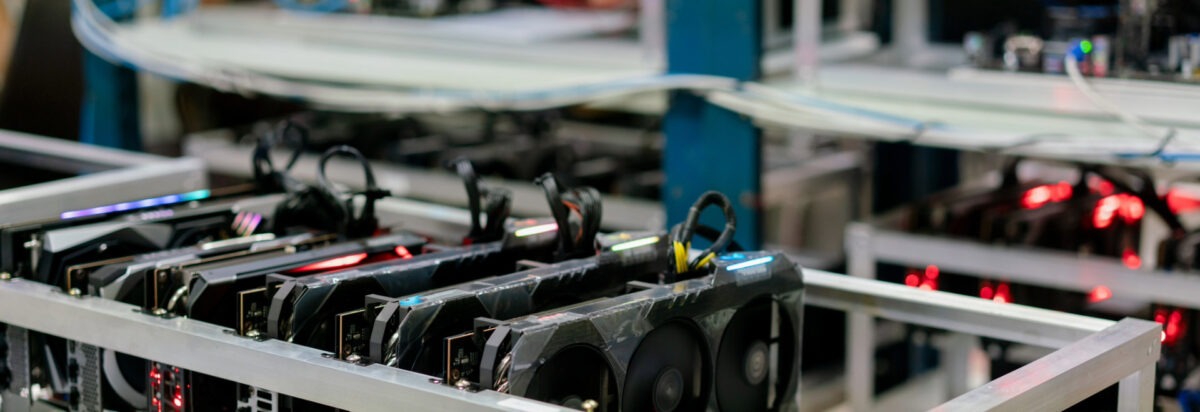$0.00
March 30, 2025

Bitcoin mining company MARA Holdings (MARA) is launching a fresh $2 billion stock offering to buy more bitcoin, continuing its plan of buying BTC in the open market through capital raise while sticking to its “Hodl” strategy.
According to a Form 8-K and a new prospectus filed with the U.S. Securities and Exchange Commission (SEC), MARA entered into an at-the-market (ATM) equity program with a group of investment banks including Barclays, BMO Capital Markets, BTIG, Cantor Fitzgerald, and others. The proceeds of the offering, which will see brokers selling shares of the miner from time to time, will be used mainly for the acquisition of bitcoin in the open market.
“We currently intend to use the net proceeds from this offering for general corporate purposes, including the acquisition of bitcoin and for working capital,” MARA said in its prospectus.
This new fresh stock sales plan follows a previous ATM offering that targeted up to $1.5 billion for the miner.
MARA has adopted Michael Saylor’s strategy of raising funds through equity and convertible bond offerings and buying bitcoin in the open market. The miner now holds 46,376 BTC in its treasury, making it the second-largest bitcoin stash among publicly traded companies, behind Strategy’s 506,137 BTC.
The plan to buy bitcoin in the open market was adopted by the miner last year, even though a miner can theoretically mine bitcoin at a discount to the spot price. The industry became challenging after last year’s halving cut mining rewards by half, squeezing profit margins on the back of rising costs. This made buying bitcoin in the open market, alongside mining, a relatively better strategy for the miners.
Read more: Bitcoin Mining Is So Rough a Miner Adopted Michael Saylor’s Successful BTC Strategy

Source link
March 29, 2025



Source link
March 28, 2025

This is part of Trump’s Great American Crypto Scam, a series about the catastrophic collision between the second Trump administration and the wild world of cryptocurrency. Read it all here.
Once upon a time, not long ago, Elon Musk was worried sick about climate change. Stopping it became an overarching career mission, reflected in both his business decisions and everyday actions. He gave the electric vehicle industry a jolt after taking over Tesla Motors in 2004. He joined President Donald Trump’s first business advisory council in 2017, then resigned in protest when Trump withdrew the United States from the Paris Agreement. He directed Tesla to buy up $1 billion worth of Bitcoin in 2021 and accept the cryptocurrency in formal transactions, only to backtrack when he remembered that Bitcoin mining is, by design, a heavily energy-intensive process that requires masses of fossil fuel–powered computer servers to run at all times. It was such a notorious moment in the crypto world that one speaker led “FUCK ELON” chants during that year’s Bitcoin conference.
What a remarkable thing, then, for Musk to embrace Trump more closely than ever as the reelected president decorates his administration with oil-industry shills and with crypto insiders, whose energy-intensive mining rigs and data centers make them something of a natural complement to the fossil fuel industry’s expansionist goals.
But of course, it tracks with his general shifts in ideology and mission since the COVID era. Scientific nerdery gave way to virus conspiracies; climate change took a back seat to his longtime A.I. fears as his former nonprofit, OpenAI, achieved staggering successes; Tesla’s dangerous self-driving cars and dubious robotics earned priority over the electrification of transport. Musk has been happy to re-embrace Bitcoin because incorporating the currency into Tesla’s assets and accounting has allowed him to artificially boost the company’s profit reports and keep investors happy. The Earth is one thing, but revenue is another.
The core issue can be boiled down to the fact that Bitcoin mining is—to put it lightly—really, really, really bad for the environment. This is primarily due to a system it relies on called “proof of work”: Take the computer servers with access to online blockchain protocols, set them up with high-efficiency chips (like those highly coveted GPUs) that can transmit more computing power at a faster rate, and run those servers 24/7 to solve the cryptographic puzzles required to unlock new Bitcoins. To replicate this operation at scale requires whole data centers’ worth of GPUs, which produce audible noise and require a lot of water to keep cool. A 2024 paper published in the journal Cell Reports Sustainability found that the water usage of U.S. Bitcoin miners alone is as much as the average yearly water consumption of 300,000 U.S. households. On top of that, a single Bitcoin transaction uses enough water to fill a swimming pool.
Much of the power used to keep these things running is sourced from fossil fuels, with all the attendant emissions. It’s been estimated that worldwide Bitcoin mining and transactions have consumed more power than countries like Finland each year. It’s worrying enough that even Republican lawmakers in crypto-friendly red states, like Arkansas, have passed bills to regulate the digital-asset industry’s noise and air pollution. (Those efforts might be undercut should Trump carry through with an ill-advised campaign promise to ensure all Bitcoin is mined within U.S. borders only. Ironically, however, his trade war with China has prevented American Bitcoin miners from securing needed equipment.)
The techno-centric vision for Trump 2.0 was laid out in various written screeds from Musk’s Silicon Valley friends at Andreessen Horowitz, the venture capital hydra (and crypto funder) whose namesake founders became enthusiastic Trump converts and staffers this election cycle. Marc Andreessen’s “Techno-Optimist Manifesto” insisted upon building out energy “abundance” instead of cutting back on any fossil-fuel use; Ben Horowitz’s “Politics and the Future” blog announcement pledged his support for any political candidate who believed, like he did, that crypto “will create a fairer, more inclusive economy”; the duo’s co-written “Little Tech Agenda” all but declared war against the regulatory state in the wake of Biden administration attempts to impose tighter crypto regulations.
With Andreessen himself having joined Musk in keenly advising Trump throughout the presidential transition, the new administration has gotten to work implementing all facets of the Andreessen Horowitz blueprint—and yes, the crypto and energy policies are not incidental, because top-down climate denial is hardly irrelevant to their goals. The Securities and Exchange Commission, now a far more crypto-friendly agency under Trump, has also scrapped a Biden-era requirement for large companies to disclose their greenhouse gas emissions in depth. The president has once again withdrawn the U.S. from the Paris Agreement, with no objection from Musk this round. In fact, his already-infamous Department of Governmental Efficiency has been targeting the National Oceanic and Atmospheric Administration and the Environmental Protection Agency for data purges, grant freezes, and mass firings. It’s not a coincidence that Musk is doing this under the aegis of a fake “department” that’s named for the Dogecoin cryptocurrency and was staffed with Marc Andreessen’s help.
(Also not a coincidence: that the primary zero-carbon energy source the new Department of Energy is interested in expanding is nuclear power, a fixation of both Andreessen’s and Horowitz’s. Why is that? Well, it’s a good way to thumb their noses at misguided environmentalists who protested fission plants after the Three Mile Island meltdown. Also, they want more data and mining centers to be powered by nuclear power specifically.)
While purges of NOAA and EPA data are troubling for many reasons, one of the biggest is that they’ve censored key resources for tracking American energy consumption and greenhouse gas emissions. Those have been especially useful markers for independent researchers surveying and tracking how America utilizes its electricity, both dirty and clean. There’s Digiconomist, the much-cited project from Dutch economist Alex de Vries, that keeps a public monitor of Bitcoin mining’s environmental and emissions impacts. There’s also the fact that this data affects the pricing and regulation of agricultural commodities—and since Bitcoin and other cryptocurrencies will be considered commodities like gold and silver, it will be the agriculture-focused members of Congress who lead legislative oversight. What could go wrong?
Digital-asset evangelists are especially sensitive to the climate critiques, which popped up time and again during the pandemic-era crypto bubble as myriad celebrities—even the nominally environmentalist ones—got in on the grift. Some crypto ventures, like the alternative currency and blockchain Ethereum, shifted to coin-mining methods that were far less energy-intensive.
But Bitcoin truthers and like-minded users are dedicated to their all-systems-go, all-the-time approach. Why should the government make it easier for anyone to scrutinize and call out their electricity needs? And why should banks and other firms express any skepticism over cryptocurrency’s actual value, or take the time to meet their climate and environmental goals, when they could just be forced to mine this stuff instead? Trump himself has been cozying up to the stuff in increasingly concerning ways, from a disastrous meme currency to a coin-hoarding private venture to the establishment of a crypto arm for his Truth Social network, dedicated data centers and all. No better way to ensure regulatory capture than to grant the president his own funny money.
To that end, why should the government do anything to oppose the “financial innovation” tech in which some powerful VCs just so happen to have staked millions of dollars? If the consequence happens to be a hotter, less-inhabitable Earth, so be it. At least the crypto mavens will have their digital riches to isolate them from the real-world consequences of these decisions.
True believers in crypto have often championed it as the answer to so many of our financial, political, and even cultural woes. It’s decentralized, giving money and power back to the people without having to rely on evil banks or governments. It allows anyone to keep their money safe from inflation and the finicky, unpredictable economy. So what if it takes a few million gallons of water and untold amounts of greenhouse gases pumped into the atmosphere each year?
This is the currency of the future. It’s just too bad that there might not be a habitable future to spend it in.
This work is made possible by Slate Plus. Please consider supporting our coverage of the second Trump administration—we won’t even make you pay in $bwainwuhm.

Source link
March 27, 2025

A crypto mine’s plans to shift from natural gas to nuclear power has opened fresh concerns from locals about cryptocurrency’s pollution footprint in an upstate New York community — and ultimately led to the adoption of a nuclear-free zone and restrictions on energy development.
North Tonawanda, a city of about 30,000 located between Buffalo and Niagara Falls, is home to a crypto mining facility run by DigiPower X, previously known as Digihost. Since opening in 2022, the facility has been a source of complaints from citizens about noise as well as air pollution, as Buffalo’s WGRZ detailed.
In February, residents gathered for an information session and then a public hearing. These meetings followed the December announcement of plans for Digihost to develop power sources with NANO Nuclear Energy, a company known for its nuclear microreactors. Digihost had begun exploring switching the energy source for its crypto facility to nuclear by 2031, per WGRZ.
In response to concerns, city officials proposed a new law that would block the development of nuclear reactors within city limits. The law would also restrict the construction and operation of other energy sources — including wind, hydroelectricity, natural gas, and coal.
A vote on the law was pushed back in February and passed in March, WGRZ reported.
The debate over this crypto mine’s power connects to broader discussions about the energy-intensive nature of mining, cryptocurrency’s pollution footprint, and whether nuclear energy is a viable option to power the industry without releasing carbon pollution.
Conventional crypto mining requires a large amount of electricity. When that electricity comes from highly polluting, dirty energy sources — such as gas-fired or coal-fired power plants — cryptocurrency’s pollution footprint is correspondingly big.
According to the U.S. Energy Information Administration, a crypto-mining facility uses lots of electricity because of the computing power needed to confirm transactions and create new currency — and the energy to cool equipment. As Investopedia detailed, not all cryptocurrencies use the same energy-intensive mining system, though the most prominent one, Bitcoin, does.
It’s important to note that exact details about crypto energy use have been hard to pin down. And many crypto operations have increased the portion of their electricity coming from cleaner energy sources — including nuclear. Nuclear energy is essentially free of carbon pollution, but it comes with its own concerns about radioactive waste and historical disasters.
Crypto proponents and researchers have noted that mining can encourage the development of renewable sources such as solar projects. However, by many accounts, crypto mining remains an energy-intensive process that can have a large carbon footprint — and can consume significant quantities of water and create noise pollution, as well.
TCD Picks » Upway Spotlight
💡Upway makes it easy to find discounts of up to 60% on premium e-bike brands
The pollution associated with crypto mining has implications at the community level — such as in North Tonawanda — and on a larger scale due to the possible impacts of air pollution on human health risks and Earth’s rising temperature.
Crypto has the potential to help communities economically and to encourage local renewable energy development. It can also cause communities headaches in dealing with pollution effects.
“The world’s transition to a digital economy, facilitated by major technological breakthroughs, has several benefits,” said a 2023 UN-led report on the impacts of Bitcoin mining. “But as the demand for exchanging and investing in digital currencies is rapidly growing, the world must pay careful attention to the hidden and overlooked environmental impacts of this growth.”
What about cryptocurrency’s pollution footprint in North Tonawanda?
In its reporting on the crypto site in North Tonawanda, WGRZ cited concerns from citizens and the city about noise and carbon pollution, as well as fears about proposed nuclear solutions.
“I’m worried about the air that I’m breathing with the emissions that they’re pumping into the air, and now what this nuclear thing can do,” city resident Mark Polito told the outlet.
For its part, the crypto company’s CEO Michel Amar said, “The opportunity to collaborate with NANO Nuclear represents a bold move toward achieving our sustainability goals.”
On March 18, the city voted in favor of the new law, raising questions about DigiPower X’s next steps.
“What we’re going to be doing moving forward … we’re going to be looking at our zoning codes and how we may or may not adapt language that would allow them in some manner,” Austin J. Tylec, the city’s mayor, told WGRZ. “But for now, we have hit the brakes on nuclear energy.
Join our free newsletter for good news and useful tips, and don’t miss this cool list of easy ways to help yourself while helping the planet.

Source link






